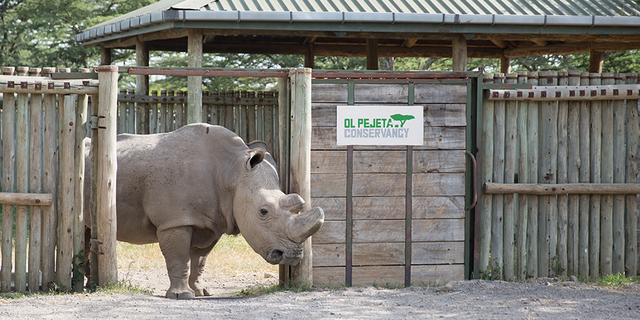
Sudan, the northern white male rhino died at the age of 45 years. Photo source: Facebook Ol Pejeta Conservancy
Sudan, the last northern male white rhinoceros in the world, has gone forever, Monday, March 19, 2018, Kenya time. Euthanasia is a tough choice to be done on this great mammal in her home, Ol Pejeta Conservation, Kenya. He is old, 45 years old, and physically weak.
His experts and loyal guardians state, the time of his death has arrived. Though heavy and sad, the fact is, Sudan's departure makes no difference to those who have sought this type of rescue.
Sudan is already paralyzed, from the waist down. Her wobbly back foot makes it impossible to ride a female to give offspring. The caretaker knew, and the vet swiftly took precautions, collecting and freezing sperm samples along with the specimens of four other previously deceased males. Hopefully, this sample of frozen sperm can be used to rescue the remaining northern white rhino species.

Sudan is the last northern male white rhinoceros in the world died of illness. Photo source: Facebook Ol Pejeta Conservancy
Sudan was arrested in Shambe, Sudan, by an animal trap employed at Chipperfield's Circus in February 1975, along with five other white rhinos when he was two years old. He was then sent to the Dvůr Králové Zoo in the Czech Republic.
In December 2009, Sudan was transferred to Ol Pejeta Conservancy, Kenya, for "Last Chance To Survive" program, along with three other white rhinos. The hope, Ol Pejeta as a more natural habitat to induce breeding.
If we learn one thing from Sudan's departure, when entering a new conservation era, traditional methods such as habitat restoration and anti-poaching schemes should be integrated with new advanced methods such as IVF (In-Vitro Fertilization), stem cell science and even editing genes.
To save the northern white rhinoceros, scientists need two basic ingredients: sperm, they have, and eggs, which are now very limited in stock. The remaining two northern white rhinoceros, have health problems and are genetically too close to Sudan to build a rhino population.

Sudan in memory. Photo source: Ol Pejeta Conservancy.org
For years, veterinarian Thomas Hildebrandt of the Leibniz Institute for Zoo and Wildlife Research in Berlin, Germany, led by The Guardian, has guided the researchers by taking biopsied skin cells from the northern white rhinos of the past. Add genes to turn them into stem cells and then try to make them into eggs.
In this way, dead animals can still pass on their genes. The egg that has grown is then fertilized with a sperm sample that is liquefied to make a new rhino mated to its closest relative, the southern white rhino.
It may be that this will be a new alternative to sustaining and preserving the lives of endangered species. Conventional conservation methods failed to save the northern white rhinoceros. Now that the only male is gone, this is the last hope.
Earlier in the world of birds, sperm from an endangered houbara bustard were "grown" in chickens which were then used to produce houbara bustard until now. In the plant world, researchers have transformed the DNA of an iconic American chestnut tree, in order to withstand invasive fungi that propel the species toward extinction, ultimately saving it from the brink of extinction.
The northern white rhino is a subspecies of the more numerous southern white rhinoceros, once exploring the great east and central African pastures. In 1960, there were more than 2,000 individuals.
With the southern white rhino, they are distinguished from more hairy ears, different tooth structures, and smaller body sizes. Some researchers argue that the northern white rhinoceros must be considered as a separate species.
War, habitat loss, and hunting for the horn have destroyed the northern white rhino population. In 2008, researchers no longer found the northern white rhino in the wild.
Meanwhile, the western black rhinoceros was declared extinct seven years ago due to poaching. The five remaining species of rhinoceros around the world today are considered threatened, according to the Save the Rhino conservation group.
Kenya alone in the 1970s had 20,000 rhinoceros, the number dropped to 400 individuals in the 1990s. Now, quoted from the Huffington Post, there are 650 individuals who mostly are black rhinoceros. (Various sources)